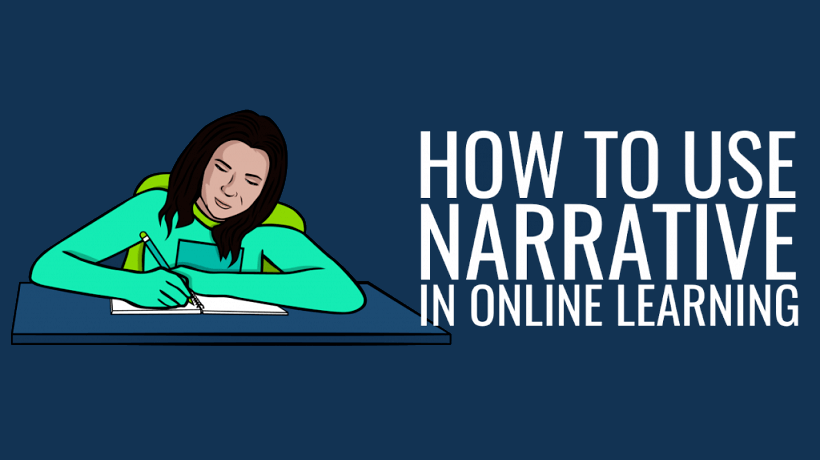How To Use Narrative In Online Learning
In a previous article, I introduced the idea of using narrative to improve a training program. It might sound like an extra task in an already full calendar, but do it right, and the payoff can be well worth it. Not only will you have a framework for your training efforts, but you might even have a little more fun!
Because stories are so versatile, every organization and every training department needs to approach narrative in their own way. Because each case is unique, it’s impossible to write down a formula that anybody can follow. There are, however, a few tips and pointers that can make the process a lot easier!
The Three-Act Structure
Before you start, it’s helpful to know what exactly a story is. Stories are made of triggers or events that happen in the main character’s journey. Every time the protagonist reacts to an event, they grow and develop. Sounds familiar, doesn’t it?
The Three-Act Structure is an easy way to visualize your story. The structure itself can be applied to the entire story, or used to create mini-narratives for each training item. Here’s how it looks:
Act One: The Setup
Here, we see the protagonist’s starting point - the ordinary world he’s used to. In this act, an incident happens which sets the main character off on their journey. In a learning program, this is the perfect fit for induction training – your new starters will easily relate to a character who is heading on a new journey into the unknown!
Act Two: Confrontation
If the main character has an easy ride, the story won’t be very interesting. Act Two is the arduous journey that ends with the main character confronting the nemesis. It’s full of obstacles, twists, turns, disasters, crises, and the odd minor victory. This is what the middle of any training initiative should look like. The more you challenge the learner, the more engaged they’ll be with the content.
The confrontation at the end of Act Two should coincide with the learning objective you’re trying to deliver. As the protagonist is confronting the nemesis, your learners might be completing an assessment and facing their own challenge.
Act Three: Resolution
All being well, your story should end with the protagonist growing in a significant way. They might be successful, or maybe the nemesis escapes to prepare for the next confrontation. Act Three is all about winding the story down and evaluating how far the main character has come. At this stage in the training program, your learner should receive feedback on their efforts. This is also a good time to suggest other training and let your learners choose the next chapter.
Tips To Use Narrative In Online Learning
Now that you’ve got an idea of the story’s shape, you can start to think of ways to build narrative into your training. Here are a few more pointers to help you out.
1. Start From Your Organizational Goals.
It’s always good to remind yourself what your organization is trying to achieve. Building the organizational goals into the narrative is an easy way to help decide which story is the right story. Not only that, but if your learners can relate the vision of the company to a story, it’ll be easier to visualize and understand.
2. Create A Strong Premise.
You never stop learning, so this story shouldn’t have a definite ending. It helps to craft a world in which to set all your stories. For example, in Growth Engineering, all of our internal training is set in a superhero universe in which the learner is constantly battling Dr. Dull and his forces of boredom. Even though that’s a simple premise, there’s a lot of scope to play around and be creative.
3. Keep It Simple.
If you overcomplicate your story, it could well overshadow the training. Worse still, you could end up writing your characters into a corner they can’t get out of. An angry group of literary critics won’t come knocking on your door because your story isn’t ‘original’. They say there are only really seven stories in the world and they’ve kept us entertained so far. Don't try to reinvent the wheel if you don't need to.
4. Make Use Of All Functionality.
The more places you weave the threads of your story, the more powerful it will be. Use quiz descriptors creatively to make your learners feel like they’re accomplishing a mission. If you can customize your Learning Management System, create homepage banners that tie into your narrative. If your learning platform is gamified, make sure all your badges make sense in the context of your narrative.
5. Use Microlearning.
If you want to build suspense, maintain curiosity and keep the learners engaged, don’t just dump the entire story in front of your learners. Give your it plenty of twists and turns with smaller, more frequent pieces of content. Not only will this make it easier for you to manage, the smaller chunks of knowledge will be easier for your learners to retain.
Final Word
There are no half-measures when it comes to building meaning into your training. For narrative to really work, it’s all or nothing. Once you’ve figured out what journey your organisation is on, you’ll be better able to convey it to the learners. If they understand their part in the bigger story, it’ll be much easier to change their behavior.
So, look at the training program you have right now and figure out where the main milestones and obstacles are. There may be a blockbuster in there just waiting to be found!
